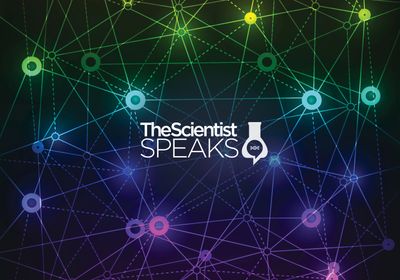ABOVE: © ISTOCK.COM, SELVANEGRA
A newly discovered type of ribosome, which synthesizes and then neatly and securely folds the proteins in sperm to prepare them for their arduous journey, seems to play a key role in male reproductive health, according to a mouse study published yesterday (December 14) in Nature. In the absence of the ribosome identified by the researchers, dubbed RibosomeST, male fertility plummeted, and in vitro tests suggest that’s because the ribosome packages proteins in a special way that enables them to last long enough to achieve fertilization.
“We need more basic science like this to understand the fundamental biology of sperm,” Kaitlyn Webster, a reproductive developmental biologist at Harvard Medical School who didn’t work on the study, tells The Scientist over email, adding that she was intrigued by the finding that protein folding plays such an important role in ensuring that sperm stay stable for as long as needed. “This knowledge will inform research studies into male infertility, male contraceptives, and overall reproductive health.”
The idea for the study stemmed from recent reports that eukaryotes appear to have heterogeneity among their ribosomes, study coauthor Xuejiang Guo, a reproductive biologist at Nanjing Medical University in China, writes in an email to The Scientist.
Guo and their colleagues began with a straightforward proteomic analysis, which was meant to detect and quantify ribosome protein heterogeneity across nine mouse tissue samples. The researchers report that they identified certain ribosomal proteins that were far more prevalent in the testes than elsewhere, which hinted that the ribosomes employed in germline cells were somehow different from those found elsewhere in the body. The team named these sperm-specific ribosomes RibosomeST to distinguish them from somatic ribosomes, then purified cell samples from the mouse tissues and ran qPCR analyses to confirm that RibosomeST was indeed expressed exclusively in germ cells, suggesting that mice have their own gamete-specific protein production factories.
It is a beautiful piece of work. It provides a serious piece of heft to the hypothesis that specialized ribosomes not only exist but have important functional consequences in cellular processes.
—Vassie Ware, Lehigh University
Ultimately, the researchers used cryo-electron microscopy to determine that RibosomeST possesses a structurally distinct exit tunnel through which newly formed polypeptide chains pass and begin to fold into their final shape. This, they write in the study, may mean that the proteins prepared by these ribosomes obtain different shapes than those synthesized by the ribosomes of other cells.
See “In Vivo Gene Therapy Cures Infertility in Mice”
“Our study provides the first evidence that a male germ cell-specific RibosomeST performed a different function, and were not replaceable by the core ribosome,” Guo says, adding that it was exciting when they found the structural differences that indicated they had a new ribosome on their hands.
To get a better sense of the importance of the structural differences, the team then created RibosomeST knockout mice. In the males, core ribosomes were unable to pick up the slack—and as a result, fertility rates—as defined by the number of live births—plummeted when knockout males were paired with wildtype females, compared to all-wildtype pairings. In addition to that measure of fertility, Guo explains that the team conducted several measurements on the male mice, observing reduced sperm count and motility, as well as “smaller testis sizes, lower testis/body weight ratio, increased ratios of abnormal sperm head and tail,” which could explain the animals’ reduced fertility. The team also tested female knockout mice “and found that they were apparent normal with normal fertility and similar litter size,” Guo writes.
Further experiments on mouse cell lines showed that RibosomeST is the only ribosome capable of properly folding proteins essential to spermatogenesis, and that the same proteins were considerably less stable when folded by other ribosomes in knockout mice that lacked RibosomeST.
“This is a BIG deal,” molecular biologist Vassie Ware, who studies ribosomes at Lehigh University but didn’t work on the new paper, tells The Scientist over email, adding that to her knowledge, there has never before been a spermatogenesis-specialized ribosome characterized to this degree. “It is a beautiful piece of work. It provides a serious piece of heft to the hypothesis that specialized ribosomes not only exist but have important functional consequences in cellular processes.”
“At this point, we should expect the unexpected from sperm,” Webster says. “Sperm are so radically different from any other cell type. They transfer between bodies, they have heads and tails, they contribute almost nothing other than their nuclear payload . . . it is not surprising that they also have specialized ribosomes.”
See “Females Gain Ground as Biomedical Research Subjects”
“What is really intriguing is why the typical ribosome core isn’t optimal for the male germline, in light of its peculiar life cycle of maturation, long waiting period, and arduous journey to fertilization,” Webster says. “Historically, it has been assumed that sperm are largely transcriptionally and translationally repressed during that time. This study adds to mounting evidence to the contrary, and explores the possibility that regulation of protein folding and stability may explain how sperm survive.”
However, she isn’t entirely convinced by the fertility findings, as she says that using the number of live births as a proxy for fertility may fail to capture potential impacts on female reproductive health, such as potential reductions in the number of immature eggs, the number of follicles, and so on. It also remains unclear whether the small number of pups born from knockout mice exhibited any developmental or fertility defects themselves, she says.
See “Opinion: Neuroscientists Need to Think about Sex (Bias)”
Whether or not this research could lead to new ways of combatting male infertility or subfertility in humans remains to be seen, Webster and Guo say. While both cite the fact that RPL39L, the ribosomal protein that makes up RibosomeST, is found in humans, Webster says work needs to be done to determine whether humans have a similar testes-specific concentration of the ribosomal proteins that make up RibosomeST. Guo adds that the team behind the study is currently screening male infertility patients for signs of the novel ribosome, saying that doing so “can help us understand its contribution to male infertility, and also help us understand the pathologic mechanisms of sperm formation defects.”
Ware similarly expresses excitement about what this study means for human health. “One would expect that these results would extrapolate to humans and affect male fertility if there are defects in this [ribosomal protein] paralogue in individuals,” she writes. The fact, she adds, that male infertility may be—at least in some cases—a “ribosomopathy” opens up new opportunities for diagnostics and potentially, in the future, “long term therapeutics.”





